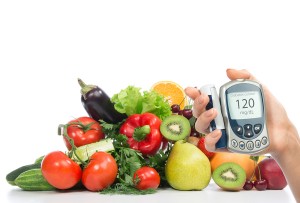It has been known for a long time that cancer cells can survive without the ordinary aerobic pathways of energy production. They can get energy from a metabolic pathway, which bypasses normal cell metabolism (aerobic glycolysis). But many attempts of designing a cancer therapy to exploit this difference have so far been unsuccessful.
This Mayo Clinic website even explains that it would be a myth that cancer would grow better with sugar. The following pieces of research question this myth.
Sugar makes cancer grow faster (activates oncogenes) in fruit flies
In this study from the Icahn School of Medicine at Mount Sinai in New York City fruit flies were used as an animal model. You may ask, why fruit flies; we are not fruit flies, we are humans! As incredible as it sounds, on a cellular level our cell metabolism and the cell metabolism of fruit flies is identical. But the generation time of fruit flies is much shorter and results can be seen in days and weeks. To achieve the same in human trials would take months and years. Also, researchers could breed a strain of fruit flies that was susceptible to develop tumors. When they were fed sugar, the fruit flies developed insulin resistance within a short time. This model was chosen by the researchers as it is known for some time that in humans insulin resistance from diabetes, obesity, and other metabolic diseases leads to a higher risk of developing breast cancer, liver cancer, colon cancer and pancreatic cancer. The researchers wanted to sort out what the metabolic advantage of the cancer cells was under these conditions.
The researchers found that the sugar in the diet activated silent cancer causing genes (called “oncogenes)” in the fruit flies that in turn helped to promote insulin resistance and the development of tumors. Because of the insulin resistance sugar could not enter into the normal body cells, but the tumor was using up all of the sugar allowing the tumor cells to multiply at a rapid rate. The end result was that the sugar from the diet fed the cancer cells directly making them grow faster. Interestingly, when these flies that had developed tumors on a high sugar diet were switched to a high protein/low sugar diet, the tumors stopped growing and were contained.
In this fruit fly example the researchers were subsequently able to block cancer cell growth by special cancer suppressing drugs (acarbose, pyrvinium and an experimental drug AD81), which were given in combination. 90% of the flies given the triple-drug treatment survived to adulthood while control flies not treated with this regimen all died of their tumors.
Although this model was only done in fruit flies and one could question whether or not this was relevant to what is happening in human cancer patients, the following piece of research puts this fear to rest.
Human breast cancer cell study in vitro
In January 2014 the American Society for Clinical Investigation published a collaborative study between the Lawrence Berkeley National Laboratory, Berkeley, California, CA and the Hokkaido University Graduate School of Medicine, Japan, which used human breast cells in tissue culture showing that sugar could cause breast cancer.
The original papers of this US/Japanese research team are quite technical and I do not expect you to understand this link where it is published. I posted it for those who want in depth information. The researchers used a simple tissue culture model where they could observe tumor growth in cell cultures under the microscope using a gel where the breast tissue samples were placed side by side with normal breast cells that served as controls. The cell cultures of both normal cells and malignant cells were obtained from the same reduction mammoplasty tissue samples. This way the cell cultures mimicked a situation as close to the reality of what is going on in a woman’s body when breast cancer develops.
The normal breast epithelial cells were seen in culture to get organized as a roundish cell formation (an acinus formation) while the cancer cells were growing as irregular cell clumps. This visual effect was reproducible and is depicted in the paper. With high sugar concentrations in the growth medium breast cancer cells multiplied at a faster rate, not so the normal cells. But some normal cells underwent a transformation into abnormal and cancerous cell types. On the other hand, when sugar concentrations were severely restricted, morphological changes took place where cancer cells slowed down their growth or stagnated while some of them even changed into the normal cell formation (acinus formation). Using various known oncogene stabilizers the investigators could show that the same effect was noted as with the low sugar concentration in the growth medium.
The investigators tested whether other cell lines of breast cancer would show similar results as to the effects of sugar feeding or restriction. They were able to show that high sugar feeding activated cancer cells, no matter where the cancer cell lines originated. The authors discussed that metformin, which is known to control the metabolism in diabetic patients and lowers blood sugar levels, has also been shown to calm down growth of cancer (due to stopping oncogene stimulation), which improves the survival rates of many different cancer types in diabetic patients; it also reduces the risk of developing cancer in those who are taking metformin.
Other investigators have shown in mouse experiments that an impressive lowering of cancer rates could be achieved with low carb diets.
Human evidence for cancer causation and cancer prevention
Several clinical studies seem to indicate that there is a higher cancer rate in diabetics where insulin resistance can lead to activation of cancer producing genes (called oncogenes) and cause various cancers. In this link colorectal cancer and pancreatic cancer are discussed in relationship to diabetes and insulin resistance. High glycemic foods (sugar, starchy foods) were associated with breast cancer, colorectal cancer and endometrial cancer. The majority of trials showed this association although not all. The more obese patients were, the more pronounced the insulin resistance was and the more the relationship to these cancers became apparent. A diet that is high in starchy foods like potatoes, rice and bread is causing pancreatic cancer as was shown by researchers at the Dana-Faber Cancer Institute, Brigham and Women’s Hospital and Harvard School of Public Health. High glycemic diets have shown to cause colorectal cancer, diabetes and being overweight. The Standard North American Diet (SAD) is a pathway to many chronic illnesses due its high load in refined carbohydrates. Ironically the abbreviation for it is “SAD”, which in my opinion reflects adequately its sad influence on health and well being. We know now that sugar and starchy foods lead to insulin overproduction, which in turn causes the metabolic syndrome (also known as “insulin resistance”). This causes the immune system to weaken and fat to be deposited as visceral fat in the stomach area. Visceral fat is metabolically very active as it secretes cytokines like tumor necrosis factor alpha (TNF alpha), COX-2 enzymes and others. Insulin and growth factors from the visceral fat gang up together with the elevated blood sugar, which activates tumor-producing genes (oncogenes) to cause cancer.
While cancer rates are higher in patients with insulin resistance, they were lower in patients who did have normal insulin levels. It is important to concentrate your efforts on normalizing weight, which will normalize insulin sensibility and avoid the development of cancer. Sugar avoidance and avoidance of cereals and starchy foods will help you achieve this goal.
Conclusion
Although the idea that sugar could cause cancer has been around since 1924 (Dr. Warburg), it has taken up to now to be proven in animals and humans.
The purpose of this blog was to show how there is a connection between the consumption of sugar and starchy foods and various cancers in man. Animal experiments are useful in suggesting these connections, but many clinical trials including the Women’s Health Initiative have shown that these findings are also true in humans. It is insulin resistance due to sugar and starch overconsumption that is causing cancer.
We are now in a position to know why people who consume a low carb diet, develop less cancer than people who consume a high carb diet. I have followed such a low carb diet (also known as low-glycemic index food diet) since 2001 and find it easy to follow. However, I do not dispute that it takes some discipline to change the old way of eating to the new one. The benefits are definitely worth it: you are feeling well now and you are staying well as you age.
More information about hyperinsulinism that can cause breast cancer: http://nethealthbook.com/cancer-overview/breast-cancer/causes-breast-cancer/
Last edited Nov. 7, 2014








